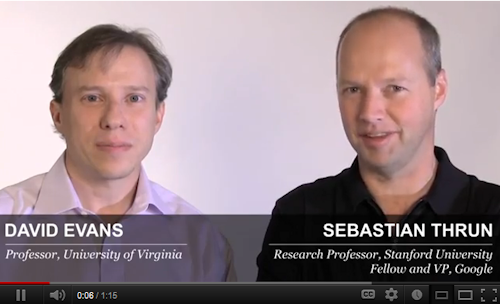For a glimpse of the disruptive future of higher education, University of Virginia stakeholders who are up in arms over the resignation of President Teresa Sullivan should enroll in a class taught by David Evans, a popular computer science professor and winner of the Outstanding Faculty Award from the State Council on Higher Education in Virginia.
You won’t have to go to Charlottesville to attend Evans’ introductory computer science class, in which you will learn how to build your very own search engine. No, you can just sign up through Udacity, an online educational service that provides access to courses taught by world-renowned university instructors.
For free.
And there’s no practical limit to how many students can enroll.
Udacity is the brain child of Sebastian Thrun, who earned his Ph.D. in computer science from the University of Bonn, migrated to Stanford University and wound up working for Google. He wanted to make his class on artificial intelligence available to a wider audience than the Stanford student body. After promoting the class online and through an Artificial Intelligence conference…. Well, I’ll let the Wall Street Journal‘s Andy Keeler tell the rest of the story:
In the end, there were 160,000 people signed up, from every country in the world, he says, except North Korea. Rather than tape boring lectures, the professors asked students to solve problems and then the next course video would discuss solutions. Mr. Thrun broke the rules again. Twenty-three thousand people finished the course. Of his 200 Stanford students, 30 attended lectures and the other 170 took it online. The top 410 performers on exams were online students. The first Stanford student was No. 411.
Mr. Thrun’s cost was basically $1 per student per class. That’s on the order of 1,000 times less per pupil than for a K-12 or a college education—way more than the rule of thumb in Silicon Valley that you need a 10 times cost advantage to drive change.
So Mr. Thrun set up a company, Udacity, that joins many other companies attacking the problem of how to deliver the optimal online education. “What I see is democratizing education will change everything,” he says. “I have an unbelievable passion about this. We will reach students that have never been reached. I can give my love of learning to other people. I’ve stumbled into the most amazing Wonderland. I’ve taken the red pill and seen how deep Wonderland is.”
Twenty-three thousand students at a cost of $1 per head? Now, that’s disruptive change. That, to borrow a phrase from Helen E. Dragas, rector of the University of Virginia and the heavy in the resignation of President Sullivan, represents an “existential threat.” Not just to Mr. Jefferson’s University, I hasten to add, but an entire higher ed establishment that is plunging millions of students into debtor’s bondage in order to pay for runaway tuition and fees.
Concludes the WSJ‘s Keeler: “This is going to disrupt public schools and teachers unions and universities and tenured professors and so on, Mr. Thrun effectively interjects: ‘The dialogue always focuses on what’s going to happen to the institutions. I’m totally siding with the students.'”
I’m not defending the manner in which Dragas handled Sullivan’s departure from the university. As I’ve made clear in previous posts, she has a lot of questions to answer. But the hang-wringing angst over Sullivan’s treatment has ignored the big picture. Higher education is in crisis and is reaching a tipping point. While Teresa Sullivan was obviously a very intelligent and thoughtful woman — read her “academic strategy” memo, and you’ll probably agree — but there is no indication in the public record that she has displayed an appropriate sense of urgency about the need to reinvent UVa’s education model. Incremental change won’t cut it at UVa, or any other institution.



